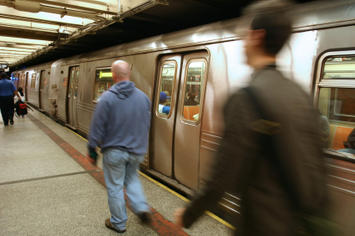
One of the most enduring urban myths suggests that most jobs are in the core of metropolitan areas, making commuting from the far suburbs more difficult. Thus, as fuel prices have increased, many have expected that people will begin moving from farther out in the suburbs to locations closer to the cores. Indeed, in some countries, such as Australia, much of the urban planning regime of the last decade has been based upon the assumption that urban areas must not be constrained because the residents on the fringe won’t be able to get to work.
Like many myths, this one has limited conformity with the truth. This can be seen even in New York, the New York metropolitan area (the combined statistical area), which is home to the second largest central business district in the country and by far the most well-developed transit system in North America. Yet, despite this, a close examination of work trip data from the 2006 U.S. Census American Community Survey shows a pattern of shorter work travel times for many of the most far-flung areas while those located closer to the core often experience longer commutes.
These findings parallel earlier Newgeography.com reports about Chicago and Los Angeles, which indicated a somewhat similar pattern. Although white-collar workers close to key job centers – such as downtown Chicago or west Los Angeles – enjoy relatively short commutes, those living in the close in, but less high-end districts tend to suffer the longest commutes.
So, somewhat surprisingly, workers who live in the outer suburbs of New York have the shorter work trip travel times, at 29.8 minutes than the New York metropolitan average of 32.9 minutes. Workers living in the inner suburbs spend 30.7 minutes getting to work. Those living in the outer boroughs of New York City have the worst commute times at 41.5 minutes. This contrasts sharply with the 30.1 minute average for workers living in the core borough – Manhattan, home of more than 2.2 million jobs.
One possible conclusion here is that the best way to balance jobs and housing is not to concentrate employment or residences in any one place. High levels of centralization are extremely convenient for those who can afford to live near the Manhattan core – where there are nearly 275 jobs for every 100 resident workers. But it is far less a good deal for those who live in the outer boroughs with only 68 jobs for every 100 resident workers. Richmond (Staten Island) has the largest deficit of jobs, with 56 per 100 resident workers, while Kings County (Brooklyn) has the lowest deficit, with 73 jobs per 100 resident workers.
In contrast, and somewhat contradictory to conventional assumption, jobs and housing are mostly in balance in New York’s suburbs. Among the inner suburban counties, there are 97 jobs for every 100 resident workers. The inner suburban counties also demonstrate a balance among themselves. The largest deficit is in Hudson County, with 89 jobs per 100 resident workers – a figure well above any of the four outer New York City boroughs. Bergen County has the highest surplus, with 102 jobs for every resident worker. Virtually all other outer suburban counties for which there is data have jobs-housing balances superior to all of the New York City outer boroughs.
A similar pattern persists in the outer suburbs where there are 93 jobs for every 100 resident worker in the outer suburban counties. Mercer County, which contains three large employment draws, the New Jersey state capital (at Trenton), Princeton University and the Route 1 information technology corridor, has 126 jobs for every resident worker (only Manhattan is higher).
The extent to which jobs have become dispersed around the metropolitan area is illustrated by the work trip travel times to job locations, rather than by residence location. The average worker commuting to Manhattan, the ultimate American business district, travels 48.5 minutes one-way to work. This is approximately double the national average. Workers commuting to the outer boroughs of New York City spend 36.9 minutes. The situation is much better in the suburbs. For jobs in the inner suburban counties, the average one-way work trip travel time is 29.3 minutes. Perhaps surprisingly, people working in the outer suburban counties spend the least amount of time getting to work, at 24.8 minutes, roughly the national average.
These findings suggest that much of the conversation about convenience and location between suburbs and cities has been distorted. The notion of suburbanites, particularly in the outer ring, enduring long commutes needs to be re-examined as should the efficiency of high dense employment centers. The greatest advantages to concentrated employment in New York, it seems, devolves to those who can afford to live closest to the central core, something increasingly out of reach for most New Yorkers. For those who can’t afford a nice apartment in Manhattan, it’s not necessarily the best of all bargains.
For details see Demographia New York Employment & Commuting: 2006.
| Attachment | Size |
|---|---|
| New_York_commuting_times.pdf | 543.83 KB |












